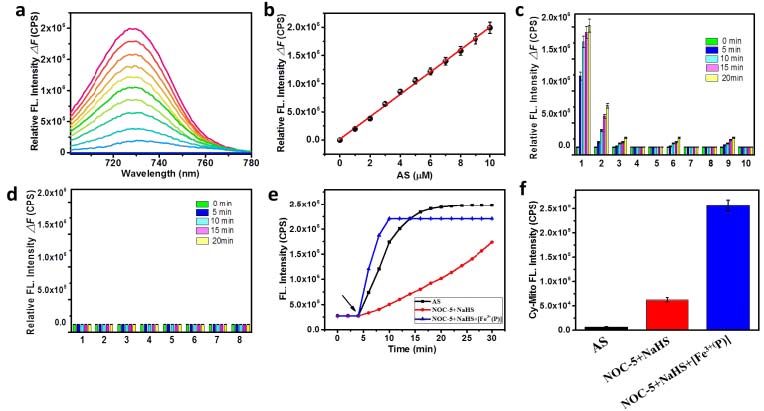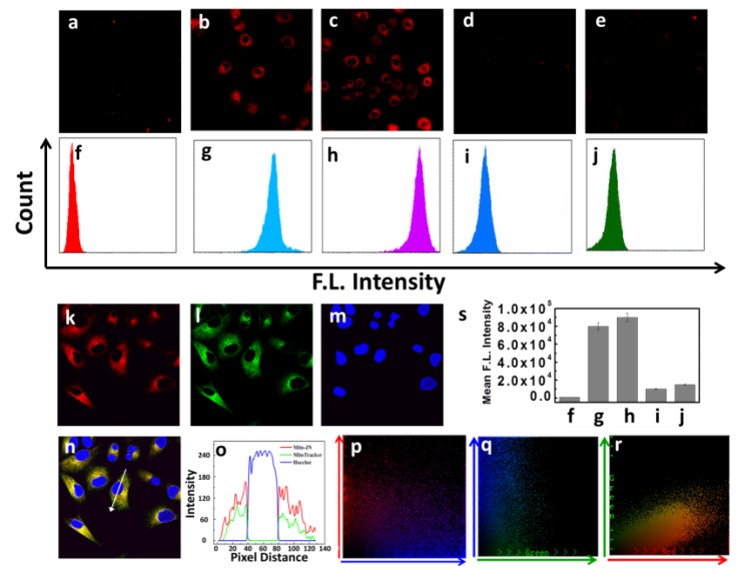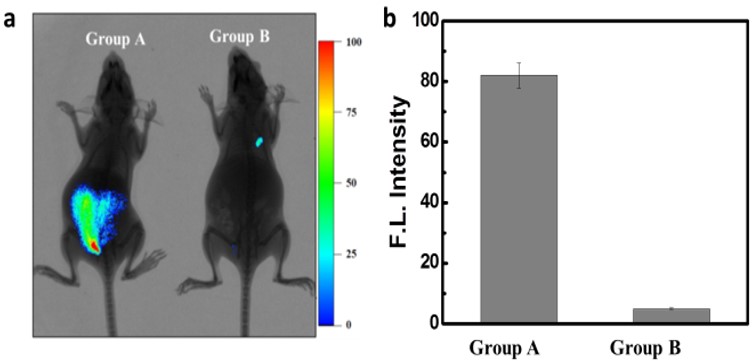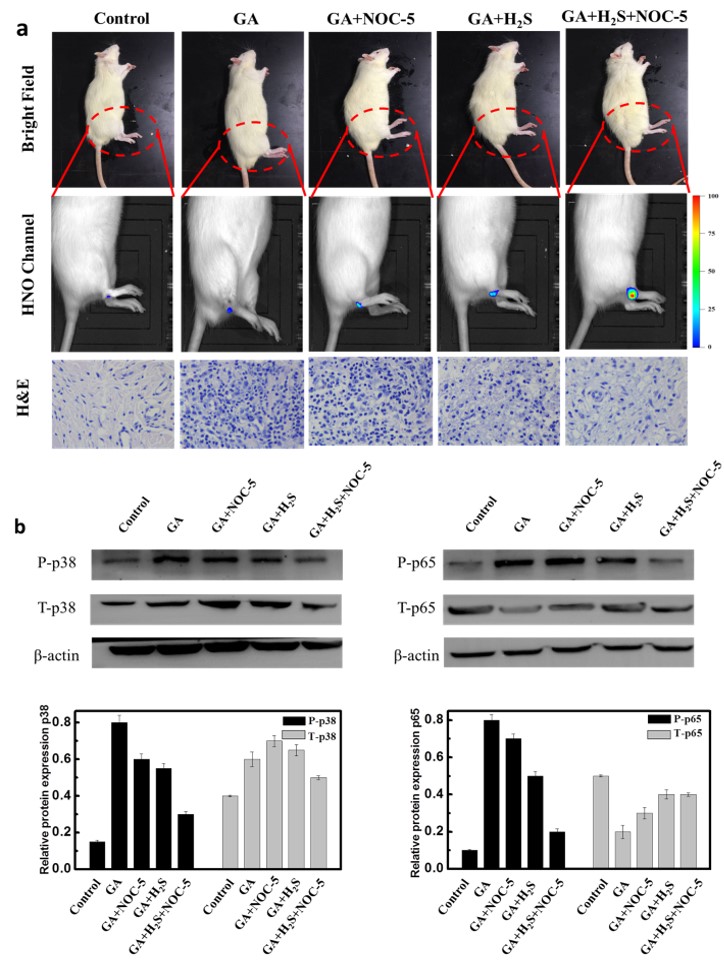博文
Imaging analysis of HNO anti-inflammatory effects
|
Imaging of HNO anti-inflammatory effects via a near-infrared fluorescent probe in cell and in rat gouty arthritis models
Yan Huang【黄严】,a,b Xia Zhang【张霞】,b,d Na He【赫娜】,b Yue Wang【王悦】,b,d Qi Kang,a* Dazhong Shen【申大忠】,a Fabiao Yu【于法标】,b,c* and Lingxin Chen【陈令新】b,e*
a.College of Chemistry, Chemical Engineering and Materials Science, Key Laboratory of Molecular and Nano Probes, Ministry of Education, Shandong Normal University, Jinan 250014, China. *E-mail: kangqi@sdnu.edu.cn
b.Key Laboratory of Coastal Environmental Processes and Ecological Remediation, The Research Center for Coastal Environmental Engineering and Technology, Yantai Institute of Coastal Zone Research, Chinese Academy of Sciences, Yantai 264003, China. *E-mail: lxchen@yic.ac.cn
c. Institute of Functional Materials and Molecular Imaging, College of Emergency and Trauma, Hainan Medical University, Haikou 571199, China. *E-mail: fbyu@yic.ac.cn,
d.University of Chinese Academy of Sciences, Beijing 100049, China
e.College of Chemistry and Chemical Engineering, Qufu Normal University, Qufu 273165, China
https://pubs.rsc.org/en/content/articlelanding/2018/tb/c8tb02494d#!divAbstract
ABSTRACT:
Nitroxyl (HNO) plays a crucial role in anti-inflammatory effect via inhibition of inflammatory pathways, but the detail of endogenous HNO generation still remains challenging due to the complex biosynthetic pathways, in which the interaction between H2S and NO simultaneously generates HNO and polysulfides (H2Sn) in mitochondria. Moreover, nearly all of the available HNO fluorescent probes are utilized for the imaging of HNO in cells and tissues, instead of the in-situ and in realtime detection of the simultaneous formation process of HNO and H2Sn in mitochondria and animals. Herein, we develop a mitochondria-targeting near-infrared fluorescent probe Mito-JN to detect the generation of HNO in cell and in rat models. The probe is consisted of three moieties: Aza-BODIPY as fluorescent signal transducer, triphenylphosphonium cationic as mitochondria navigator, and diphenylphosphino-benzoyl as HNO-response unit. The response mechanism is based on the aza-ylide intramolecular ester aminolysis reaction with fluorescence emission-on. Mito-JN displays high selectivity and sensitivity towards HNO than other various biologically relevant species. Mito-JN has been successfully applied for the detection of endogenous HNO generation which is derived from the crosstalk between H2S and NO in living cells. The additional generated H2Sn are also verified using our previous probe Cy-Mito. The anti-inflammatory effect of HNO is evaluated in LPS-evoked inflammatory cell models and in rat gouty arthritis models. The result makes our probe be a good candidate for the assessment of HNO-protective effects in inflammatory process.
Scheme 1. Proposed mechanism of the reaction of Mito-JN with HNO.

� �
�
Figure 1. a) Fluorescence responses of Mito-JN (2 μM) to different concentrations of Angeli’s salt (AS) with emission ranging from 670 to 750 nm. λex= 694 nm. b) The linear relationship between the relative fluorescence intensity at 700 nm and concentrations of AS (0 - 10 μM). c) Time-dependent fluorescence response of 2 μM Mito-JN to the testing species in HEPES buffer solution (10 mM, 0.5% TW 80, pH 7.4): 1, 10 μM AS; 2, 20 μM GSNO; 3, 200 μM ONOO-; 4, 50 μM NOC-5; 5, 500 μM NO2-; 6, 200 μM H2O2; 7, 100 μM O2-; 8, 20 μM MeLOOH; 9, 200 μM ClO-. d) 1, 50 μM L-cys; 2, 100 μM GSH; 3, 500 μM NaHS; 4, 200 μM ascorbic acid; 5, 200 μM tocopherols; 6, 50 μM L-arg; 7, 200 μM tyrosine (Tyr); 8, 50 μM hydroxylamine (HA). Bars represent fluorescence intensity during 0, 5, 10, 15, and 20 min after addition of various compounds. e) Time-dependent fluorescence intensity of probe Mito-JN (2 μM) towards AS, NOC-5 (1 mM) +NaHS (100 μM) and NOC-5 + NaHS + [Fe3+(P)] (1 μM) during 30 min. f) Detection of H2Sn by fluorescence responses of Cy-Mito (2 μM) in AS, NOC-5 (1 mM) +NaHS (100 μM) and NOC-5 + NaHS + [Fe3+(P)] (1 μM) treated for 10 min. Mito-JN: λex = 694 nm, λem = 700 nm. Cy-Mito: λex = 730 nm, λem = 780 nm. Spectra were acquired in HEPES buffer solution (10 mM, 0.5% TW 80, pH 7.4).

Figure 2. Confocal microscopy images and flow cytometry assay of RAW 264.7 cells for the detection of HNO. All the cells were incubated with Mito-JN (1 μM) for 20 min, then washed with DMEM to remove the redundant probe. a) RAW264.7 cells incubated with 1 μM Mito-JN for 20 min at 37 °C, and washed with DMEM. b) Performed as described in part a but additionally added 100 μM AS for 20 min. c) Performed as described in part a but additionally added NOC-5 (1 mM) and NaHS (100 μM) for 20 min. d) After treated as indicated as part a, incubated cells with NaHS (100 μM). e) After treated as indicated as part a, stimulated cells with NOC-5 (1 mM). f) – j) Flow cytometry assay of RAW 264.7 cells correspond with a – e. k) RAW264.7 cells incubated with 1 μM Mito-JN and then added NOC-5 (1 mM) and NaHS (100 μM). l) Fluorescence imaging of MitoTracker Green FM. m) Fluorescence imaging of Hoescht 33342. n) Merged red, green and blue channels. o) The intensity profile of regions of interest (white line in n) across cells. p) The colocalization areas of the red and blue channels selected. q) The colocalization areas of the green and blue channels selected. r) The colocalization areas of the green and red channels selected. s) Mean fluorescence intensity of parts f − j. Mito-JN (red channel: λex = 680 nm, λem = 690 - 720 nm). MitoTracker Green FM showing mitochondria (green channel: λex = 488 nm, λem = 500 - 580 nm). Hoechst showing nuclei (blue channel: λex = 405 nm, λem = 425 - 525 nm). Images are representative of n = 5 independent experiments. Scale bar = 10 μm.

Figure 3. Generation of endogenous HNO and H2Sn in living U87 cells. a) Confocal microscopy images and flow cytometry assay of U87 cells for the detection of endogenous HNO and H2Sn. b) Treatment mode of eight groups of cells. c) Mean fluorescence intensity of eight groups in part a. Mito-JN (red channel: λex = 680 nm, λem = 690 - 720 nm). Cy-Mito (red channel: λex = 730 nm, λem = 750 - 800 nm). Images are representative of n = 5 independent experiments. Scale bar = 10 μm.

Figure 4. Anti-inflammatory effect of HNO in inflammatory cell model. And the protein expression of P-p38 and P-p65 in cells. a) Confocal microscopy images, flow cytometry assay and apoptosis analysis of inflammatory cell model for the detection of HNO and H2Sn. Apoptosis analysis: (Q1) necrotic, (Q2) late apoptosis, (Q3) viable, (Q4) early apoptosis. b) Western blotting analysis of P-p38, T-p38, P-p65 and T-p65 of part a. β-actin was used as a loading control. c) Illustration of generation of endogenous HNO and H2Sn in living cells. Mito-JN (red channel: λex = 680 nm, λem = 690 - 720 nm). Cy-Mito (red channel: λex = 730 nm, λem = 750-800 nm). Images are representative of n = 5 independent experiments. Scale bar = 10 μm.

Figure 5. Fluorescence/X-ray images of BALB/c mice visualizing HNO level changes using Mito-JN. a) Mice in group A were peritoneal (i.p.) cavity injected with 50 μM Mito-JN (50 μL in 1:9 DMSO/saline v/v) for 20 min and then injected AS (500 μM, 50 μL in saline) for more 20 min. Mice in group B were peritoneal (i.p.) cavity treated with 50 μM Mito-JN (50 μL in 1:9 DMSO/saline v/v) for 20 min. b) Mean fluorescence intensity of Group A and Group B. Images displayed represent emission intensities collected window: 690-750 nm, λex= 680 nm. Data are presented as mean ± SD (n = 5).

Figure 6. Representative in vivo NIR fluorescence imaging for visualizing HNO in rat gouty arthritis models. H&E (hematoxylin and eosin) staining of synovial membrane tissue of ankle joint. And the protein expression of P-p38 and P-p65 in synovial membrane tissue. a) The bright field of five groups, fluorescence imaging of HNO of five groups, H&E staining of synovial membrane tissue of five groups. b) Western blotting analysis of P-p38, T-p38, P-p65 and T-p65 of part a. β-actin was used as a loading control. Images displayed represent emission intensities collected window: 690-750 nm, λex= 680 nm. Data are presented as mean ± SD (n = 5).
https://blog.sciencenet.cn/blog-2438823-1149702.html
上一篇:Mitochondria-targeting probe for imaging of cysteine
下一篇:far-red probe for visualizing intracellular peroxynitrite
全部作者的其他最新博文
- • Triphenylamine-AIE Materials for Cancer Theranostics
- • Fluorescent Probe forRatiometric Monitoring of Peroxynitrite
- • Fluorescence Probe for Pathological Stages of Wound Healing
- • Macrophage M2 polarization to neurological damage
- • SERS-RCA biosensor for profiling dual miRNAs
- • a glutathione-activated near-infrared fluorescent probe